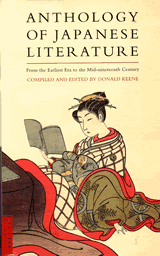
May Issue
June Issue
Anthology
of Japanese Literature
Donald Keene (ed)
Tuttle Publishing hit pay dirt when they published Anthology of Japanese Literature by Donald Keene. Keene, an accomplished professor of Japanese culture and language, produces this book with style, selecting excellent translations and excerpts that would leave any reader hungry for more Japanese lit.
I certainly felt like I was given the short end of the stick on some of the stories. The brief excerpt for Heike no Monogotari (Tale of the Heike) certainly whetted my appetite for the complete text. The Sannin Hoshi (Three Priests) is one of the best Buddhist stories I've ever read -- if only the last story of the priest was told. The Koshoku Gonin Onna (5 Women Who Loved Love) was equally entertaining and painfully incomplete. But Keene's title reads "Anthology" which meant that only a sampler plate is offered in this 442-page book.
Some of the highlights of this impressive collection include sections from Tales of Ise, Naruto Chujo Monogotari, Hakkenden and Hizakurige. Of course, no Japanese Anthology is complete without a piece from Genji Monogotari (Tale of Genji). Donald Keene wisely chooses the chapter on Yugao, one of the more exciting parts of Arthur Waley's translation.
I'm not a fan of plays or poetry and my library has fewer than 5 books of poetry. Anthology of Japanese Literature has a huge selection of poetry which occasionally made reading tedious for one accustomed to narratives. The Man'yoshu, written during the Ancient Period, had the best poems, tackling such topics as loneliness, poverty and of course love. The Kokinshu is equally easy to read and appreciate with moving poetry that didn't overexert the brain or the senses (which Western poetry always attempts to do). Although it was interesting to read the No Plays in text form, I am sure it is nothing compared to the real thing. Still, it was fairly entertaining though again I do not really appreciate stage productions.
I was also surprised by the bulk of text devoted to journals and reflections. I had enjoyed most of The Pillow Book, though it eventually became a chore to finish. Anthology of Japanese Literature contains works in the same genre such as the Tosa Diary, Lady Murasaki's Diary and Sarashina Diary. Kagero Nikki, essays by an abandoned noblewoman, was the best written. Equally interesting was Tsurezure-Gua (Essays in Idleness) by Yoshida Kenko. Being a male writer made his thoughts closer to mine (The Sarashina, Murasaki diaries and Kagero Nikki were written by females).
I was especially thankful the selections from the Kojiki and the Uji Collection were short (though typical). Some peculiar works were the Lady Who Loved Insects, Captain of Naruto, Nippon Eitaigura (Eternal Storehouse) and the Wayward Wife. My personal favorite was the Account of My Hut, which was a moving exposition of the hardships and simplicity of life. It was not religious by any means but man's pure thoughts on the question of how to live and die.
Although I would have liked to have less poetry and plays and more prose in the Anthology of Japanese Literature, I cannot deny it lives up to its title. It certainly does give a unique representation of the broad phenomonen that is Japanese Literature. Hopefully, Tuttle Publishing would release the original text of the tales or publish Volume 2 of this powerful collection.
Rating:
![]()

Anthology of Japanese Literature
First publishing 1955
Donald Keene (ed.)
www.tuttlepublishing.com
 |
 |
 |
 |
 |